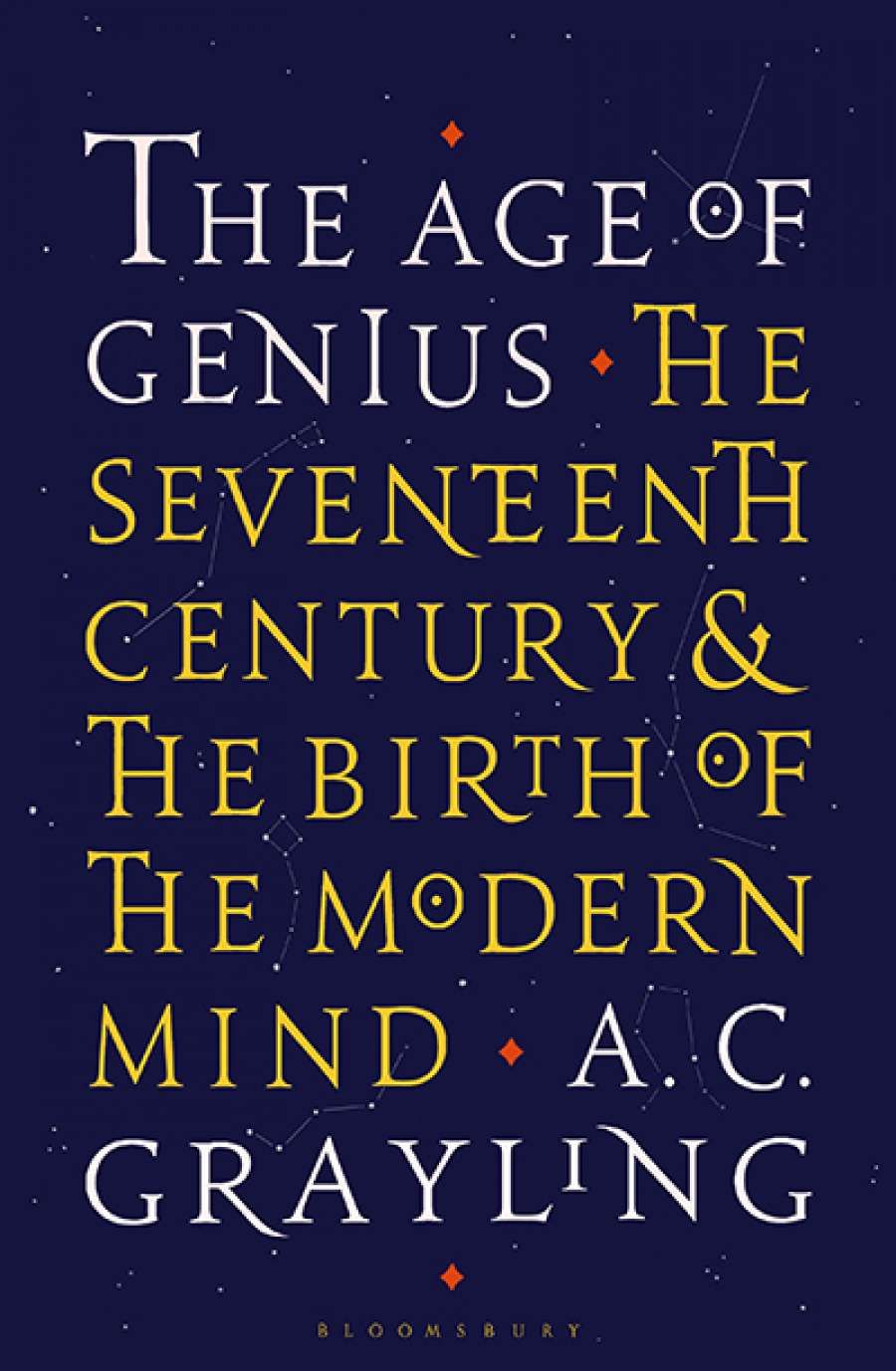
- Free Article: No
- Contents Category: History
- Custom Article Title: Kristian Camilleri reviews 'The Age of Genius: The seventeenth century and the birth of the modern mind' by A.C. Grayling
- Custom Highlight Text:
The seventeenth century was unquestionably one of the most tumultuous and transformative periods of European history. It was a century that saw Europe ravaged by war ...
- Book 1 Title: The Age of Genius
- Book 1 Subtitle: The seventeenth century and the birth of the modern mind
- Book 1 Biblio: Bloomsbury $27.99 pb, 368 pp, 9781408870389
Regrettably, however, the book is littered with historical inaccuracies that have long since been dispelled by historians of science. Nowhere is this more evident that in Grayling’s portrayal of the clash between science and religion. Giordano Bruno, we are told, was burned at the stake for ‘among other things – advocating the Copernican view’ that the earth revolves around the sun. This popular myth has been repudiated several times. While Bruno did indeed endorse the Copernican view, this was not among the list of heresies for which he was put to death in 1600. Nor could it have been. The Church only decreed the Copernican doctrine to be heretical in 1616, some seventy years after the publication of Copernicus’s book.
Further errors crop up as Grayling recounts the triumph of the Copernican view against religious dogmatism. The original Copernican system was not, as Grayling suggests, more accurate than the earth-centred Ptolemaic system in fitting the observational data. Nor did it do away with the use of epicycles. The reader is left with the impression that by the time Galileo wrote his highly controversial Dialogue on the Two Chief World Systems in 1632, the scientific case for Copernicanism was beyond doubt and the only thing holding back its acceptance was the fear of persecution. Yet many of the leading Jesuit scholars of the time accepted Galileo’s telescopic observations (and made many more of their own), accommodating them within the earth-centred Tychonic system. Galileo’s unsuccessful attempt to clinch the argument for Copernicanism in the last chapter of the Dialogue – his argument from the tides – was recognised by most of his contemporaries to be seriously flawed.
It might be argued that all this is to miss the point. What was really at stake here was not the cogency of Galileo’s arguments, but the suppression of intellectual freedom by a repressive religious authority. There is an element of truth to this. But Grayling makes no attempt to situate the Galileo affair within its wider social, political, and intellectual context. Little attention is devoted to Italian court culture, or the social and political conditions of the Counter-Reformation and the political contingencies of the Thirty Years War. Nor is there any discussion of how theological attitudes to the interpretation of Scripture, and its relationship to science, may have changed over time, or how religious attitudes were different elsewhere in Protestant Europe, or for that matter, in the Roman Empire or the medieval Islamic world.
Much of Grayling’s case for conflict of science and religion rests on his account of the Galileo affair. Yet, here we might ask: to what extent was this singular episode representative of relations between science and religion more broadly? On this question, there is a disappointing lack of engagement with much recent scholarship on the subject. Grayling conveniently overlooks the fact that the Jesuits made enormous contributions to fields such as astronomy, optics, and mechanics in the seventeenth century. Not only were Jesuits like Pierre Gassendi and Marin Mersenne among the leading lights of the Scientific Revolution, but it was largely through the establishment of the Jesuit Colleges that the mathematical sciences acquired greater prominence than they had in the universities.
 A.C. Grayling (photograph by Alasdhair Johnson, Wikimedia Commons)Far from representing the triumph of the secular intellect, many of the leading lights of the Scientific Revolution – Kepler, Descartes, Newton, Boyle, Leibniz – saw their contributions to the new science as a positive force for religion, even as an antidote to atheism. By the end of the seventeenth century, the relationship between science and religion had fundamentally changed, but theological motivations remained inextricably part of the scientific enterprise. Here we might also note that traditional forms of political authority and views that would today be considered ‘pre-modern’ continued to dominate the eighteenth century. Grayling concedes the ‘transformation of worldview was not complete until after Darwin’. But this is already to suggest that the seventeenth century, while signifying a decisive break with the past, might not have ushered in the modern mind.
A.C. Grayling (photograph by Alasdhair Johnson, Wikimedia Commons)Far from representing the triumph of the secular intellect, many of the leading lights of the Scientific Revolution – Kepler, Descartes, Newton, Boyle, Leibniz – saw their contributions to the new science as a positive force for religion, even as an antidote to atheism. By the end of the seventeenth century, the relationship between science and religion had fundamentally changed, but theological motivations remained inextricably part of the scientific enterprise. Here we might also note that traditional forms of political authority and views that would today be considered ‘pre-modern’ continued to dominate the eighteenth century. Grayling concedes the ‘transformation of worldview was not complete until after Darwin’. But this is already to suggest that the seventeenth century, while signifying a decisive break with the past, might not have ushered in the modern mind.


Comments powered by CComment